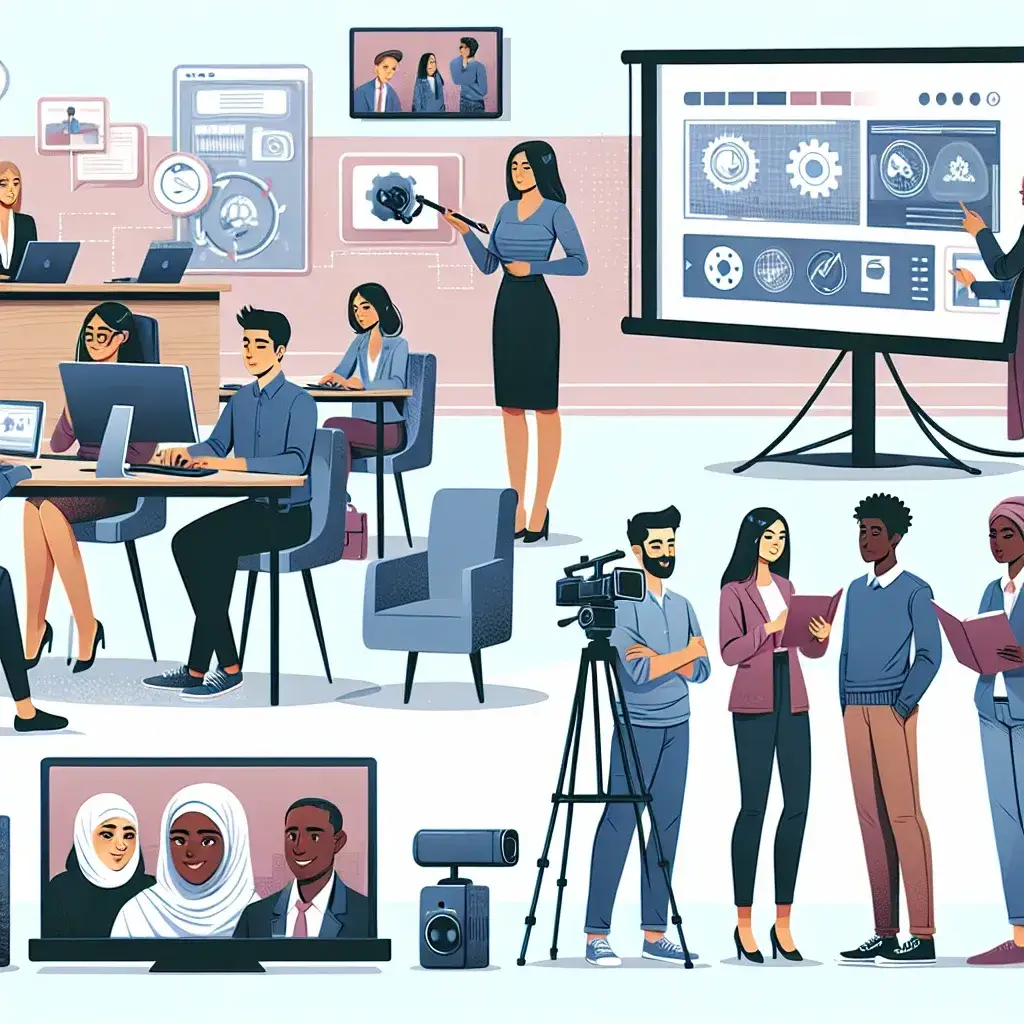The Strategic Importance of Employee Training Videos in Modern Workplaces
In today’s rapidly evolving business landscape, organizations face the constant challenge of keeping their workforce updated with new skills, procedures, and knowledge. Traditional training methods, while still valuable, often fall short in terms of engagement, retention, and cost-effectiveness. Employee training videos have emerged as a powerful solution that addresses these limitations while providing scalable, consistent, and accessible learning experiences.
The shift toward video-based learning isn’t merely a trend—it’s a response to changing workforce expectations and learning preferences. Research indicates that visual learners comprise approximately 65% of the population, making video an ideal medium for knowledge transfer. Furthermore, training videos offer the flexibility that modern employees demand, allowing them to learn at their own pace and revisit content as needed.
Pre-Production Planning: Laying the Foundation for Success
Before diving into the technical aspects of video creation, successful training video development begins with thorough planning. This phase determines the effectiveness and impact of your final product.
Defining Learning Objectives and Target Audience
The first step involves clearly articulating what employees should know, understand, or be able to do after watching the training video. These learning objectives should be specific, measurable, achievable, relevant, and time-bound (SMART). Consider your audience’s existing knowledge level, learning preferences, and the context in which they’ll consume the content.
For instance, a training video for new customer service representatives will differ significantly from one designed for experienced managers learning about new software implementation. Understanding your audience enables you to tailor the content’s complexity, tone, and delivery method appropriately.
Content Structure and Scriptwriting
Effective training videos follow a logical structure that facilitates learning and retention. Begin with a clear introduction that outlines what will be covered and why it matters. The main content should be organized into digestible segments, each focusing on a specific concept or skill. Conclude with a summary that reinforces key points and provides clear next steps.
When writing your script, prioritize clarity and conciseness. Use conversational language that resonates with your audience while maintaining professionalism. Incorporate storytelling elements where appropriate, as narratives help create emotional connections and improve information retention.
Essential Equipment and Technical Considerations
While professional-quality training videos don’t necessarily require Hollywood-level equipment, certain technical standards must be met to ensure effective learning outcomes.
Camera and Audio Equipment
High-quality audio is arguably more important than video quality in training content. Poor audio can completely derail the learning experience, while viewers are generally more forgiving of moderate video quality issues. Invest in a reliable external microphone or audio recording system to ensure clear, crisp sound throughout your production.
For video capture, modern smartphones can produce acceptable quality for many training scenarios, though dedicated cameras offer greater control and flexibility. Consider factors such as lighting conditions, shooting environment, and desired visual style when selecting equipment.
Lighting and Visual Setup
Proper lighting significantly impacts video quality and viewer engagement. Natural light from windows can work well for budget-conscious productions, but artificial lighting provides greater consistency and control. The key is ensuring your subject is well-lit and that there are no distracting shadows or harsh contrasts.
Pay attention to your background and overall visual composition. A clean, professional-looking environment helps maintain viewer focus on the content rather than visual distractions.
Production Techniques for Engaging Training Content
The production phase is where your planning comes to life. Effective training video production involves several key techniques that enhance learning outcomes.
Incorporating Multiple Learning Modalities
Successful training videos appeal to different learning styles by incorporating visual, auditory, and kinesthetic elements. Use graphics, animations, and text overlays to reinforce spoken content. Include practical demonstrations where applicable, and consider interactive elements that encourage active participation.
Screen recordings are particularly valuable for software training, allowing viewers to see exactly what they should expect on their own screens. Combine screen captures with voice-over narration that explains each step clearly and provides context for the actions being demonstrated.
Maintaining Viewer Engagement
Attention spans vary, but research suggests that optimal training video length falls between 5-15 minutes for most topics. Longer content should be broken into modules or chapters to prevent cognitive overload. Use techniques such as varying shot angles, incorporating graphics, and changing pace to maintain visual interest.
Consider the psychological aspects of learning when structuring your content. Start with familiar concepts before introducing new information, and provide regular opportunities for viewers to process and apply what they’ve learned.
Post-Production: Polishing Your Training Content
Post-production is where good footage becomes great training content. This phase involves editing, enhancing, and optimizing your video for maximum educational impact.
Editing for Clarity and Flow
Effective editing removes unnecessary content while maintaining natural flow and pacing. Cut out long pauses, filler words, and tangential discussions that don’t serve the learning objectives. Add transitions between sections to guide viewers through the content logically.
Include captions or subtitles to improve accessibility and accommodate different learning preferences. Many viewers watch training videos with sound off or at reduced volume, making visual text crucial for comprehension.
Adding Visual Elements and Graphics
Strategic use of graphics, animations, and text overlays can significantly enhance learning outcomes. Use these elements to highlight key points, provide additional context, or break down complex concepts into manageable components. However, avoid overwhelming viewers with excessive visual information that competes with the primary content.
Consider creating custom graphics that align with your organization’s branding and visual identity. Consistent visual elements help reinforce company culture while maintaining professional appearance.
Technology Tools and Platforms for Training Video Creation
The modern market offers numerous tools and platforms designed specifically for creating training content, ranging from simple screen recording software to comprehensive e-learning authoring systems.
Budget-Friendly Options
For organizations with limited budgets, several free and low-cost options provide surprising functionality. Screen recording tools like OBS Studio or Loom enable creation of software training videos with minimal investment. Basic video editing can be accomplished using free software such as DaVinci Resolve or even built-in options like iMovie for Mac users.
These tools often provide sufficient capability for straightforward training content, particularly when combined with careful planning and good production practices.
Professional-Grade Solutions
Organizations requiring more sophisticated features might consider professional video editing software like Adobe Premiere Pro or Final Cut Pro. These platforms offer advanced editing capabilities, extensive effects libraries, and professional-quality output options.
Specialized e-learning authoring tools such as Articulate Storyline or Adobe Captivate provide features specifically designed for training content, including interactive elements, quizzing capabilities, and learning management system integration.
Distribution and Implementation Strategies
Creating excellent training content is only half the battle—effective distribution and implementation ensure that your videos achieve their intended learning outcomes.
Choosing the Right Platform
Consider where and how employees will access training videos when selecting distribution platforms. Learning management systems (LMS) provide centralized access and tracking capabilities, while video hosting platforms like Vimeo or YouTube offer broader accessibility and sharing options.
Some organizations benefit from hybrid approaches that combine multiple distribution channels to accommodate different use cases and access preferences.
Measuring Effectiveness and Gathering Feedback
Implement systems to track video performance and learning outcomes. Analytics such as completion rates, replay frequency, and viewer engagement patterns provide insights into content effectiveness. Regular feedback collection helps identify areas for improvement and informs future training video development.
Consider implementing assessments or practical applications that allow employees to demonstrate their understanding of video content. This approach reinforces learning while providing measurable evidence of training effectiveness.
Best Practices for Long-Term Success
Sustainable training video programs require ongoing attention and continuous improvement. Establish processes for regular content review and updates to ensure information remains current and relevant.
Create style guides and templates that maintain consistency across different training videos while streamlining future production efforts. Document successful techniques and lessons learned to build organizational knowledge and improve efficiency over time.
Consider developing internal capabilities for training video creation rather than relying solely on external vendors. This approach provides greater control over content, timing, and costs while building valuable skills within your organization.
Conclusion: Transforming Employee Development Through Video
Creating effective training videos for employees requires careful planning, appropriate technology, and attention to learning principles. While the initial investment in equipment, skills, and time may seem substantial, the long-term benefits of scalable, engaging, and consistent training content far outweigh the costs.
Success in training video development comes from understanding your audience, clearly defining learning objectives, and consistently applying best practices throughout the production process. As technology continues to evolve and workplace learning preferences shift toward digital formats, organizations that master training video creation will maintain competitive advantages in employee development and retention.
The journey from concept to completed training video may seem complex, but breaking it down into manageable phases—planning, production, post-production, and distribution—makes the process achievable for organizations of any size. Start with clear objectives, focus on quality over quantity, and continuously refine your approach based on feedback and results. With persistence and attention to detail, your training videos can become powerful tools for employee development and organizational success.



